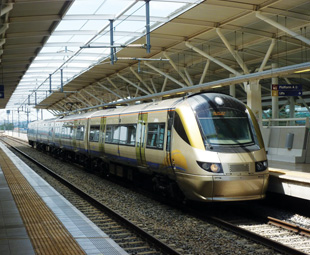The story of the two “Gs”

Let’s talk about two “Gs” this month. They are Go!George and the Gautrain. Both of them have crucial implications for public transport in South Africa.
It’s good to see that Go!George has at last come on stream. Its website shows that a rudimentary service has been introduced on a three-route “network”. The service runs seven days a week, starting at 06:00 and continuing until 23:00. Considering the problems that have been experienced, including at least one taxi-related killing, this is a reasonable start.
It needs to expand quickly, however, including routes to Knysna, Oudtshoorn and Mossel Bay, as originally planned. (We need to roll out the concept all over the country.) It’s also good to see that the headway has been improved from 60 to 30 minutes at certain times. Between one town and another 60 minutes may be OK, but ten to 15 minutes is essential for urban areas.
So, good luck George – as I pointed out way back in November 2013, you must succeed.
Which brings us to the Gautrain – another “solution” to public transport problems which, unlike George, has had five years to prove its worth, but its performance so far can only be described as dismal. It has become an international case study in how not to improve public transport. What must be done?
Before we try to answer that question, let’s go back 13 years, to an exchange of views between Romano del Mistro, then a professor of civil engineering at the University of Pretoria, and the long-serving Jack van der Merwe, then promoter-in-chief of the Gautrain and currently head of the Gautrain Management Authority (GMA).
Van der Merwe has also chaired the committee responsible for the Gauteng 25-year integrated transport plan (the bus component of this plan was recently criticised in the March Hopping Off column).
In the July 2002 issue of Civil Engineering, the magazine of the South African Institute of Civil Engineers, Del Mistro queried several aspects of the Gautrain. Space allows us to consider only two of the professor’s concerns: first, the promised capacity; second, whether the civil engineering profession was merely collecting fees for doing construction projects, instead of doing things that would produce real value for money and which would serve the entire community.
Predictably, on both counts, Van der Merwe disagreed with Del Mistro. He said: “The capacity of the Gautrain system, as currently specified, is 48 000 passengers per hour and can increase to 72 000 passengers per hour if the headway is reduced to three minutes from ten minutes”.
That was before financial and time constraints forced the project to settle for a single-track tunnel between Sandton and Johannesburg Park Station. This has limited the train’s capacity on that section to less than
20 000 passengers per hour (assuming packed eight-coach trains in both directions). Currently the service runs every 12 minutes (nowhere close to three minutes). So much then for “as currently specified”.
Van der Merwe’s response to Del Mistro’s second point was similarly dismissive: “It is a sad day for the engineering profession in our country if a professor of civil engineering implies that civil engineers (…) are interested only in consultancy fees and engineering work”.
The latest judgment of the Supreme Court of Appeal on the South African National Roads Agency Limited (Sanral) issue in Cape Town underscores just how “sad” the situation has become. As Dave Marrs, a Cape Town journalist puts it: “We were way too complacent all those years ago when Sanral was cooking up its urban toll plans”.
Let’s not be too hard on civil engineers only, though, as several other “professions” – including accountants, economists, lawyers, sociologists and town planners – must also share responsibility for the existing mess in public transport.
So, if George must succeed, what is to be done with the Gautrain? Here are some ideas.
First, dissolve the Gautrain Management Agency and incorporate it into the Passenger Rail Agency of South Africa (Prasa). Neither of these two organisations has much of a track (sorry!) record, so we may as well have one layer of management to run the whole show.
Then, charge a fare based on Metroplus Express class plus 50 percent. The resulting increase in demand will require some Gautrain coaches to have all their seats removed. That shouldn’t be a problem though – a recent complaint on the Hellopeter website referred to passengers being “squashed like potatoes” in any event.
Then get the feeder buses to do some real work. Start with some of the 164 routes in the 25-year plan.
Vaughan Mostert developed a love for public transport early in life, which led to a lifelong academic interest in the subject. He recently retired as a senior lecturer from the Department of Transport and Supply Chain Management at the University of Johannesburg. Through Hopping Off, Mostert leaves readers with some parting food for thought as he continues his push for change in the local public transport industry.
Published by
Focus on Transport
focusmagsa




